Abstract
The peculiarity of additive manufacturing is that steps are formed on the product surface resulting from the layered building. The steps’ dimensions are determined by the deviations of the real surface from its correct shape specified by 3D model of the product. The orientation of the 3D model of the product in the workspace of the additive machine and the building step are the main factors determining the sizes of the steps. The article presents the results of a statistical analysis of deviations from the correct shape of the product surface obtained by additive manufacturing and based on a 3D model. Industrial products with varying surface complexity were selected as test 3D models. These 3D models were studied in a variety of orientation options in the workspace of the additive machine. Slicing 3D models were used to form a set of layers according to strategies, with a constant and variable step. The obtained results of the statistical analysis allow scientifically substantiated assessment of the efficiency of the joint solution of optimization tasks to determine the slicing parameters and rational orientation of the product in the workspace of an additive machine, depending on its complexity.
1. Introduction
Despite intensive development of additive manufacturing (AM), efficiency is at a low level in terms of the resulting surface quality, productivity, and production cost [1]. One of the explanations for this is the peculiarities of shaping layer-by-layer building and the complexity of solving optimization problems of technological process planning for additive manufacturing.
One of the main optimization tasks for AM processes’ planning is the orientation of the 3D model of the product, and its placement in the workspace of additive machines, followed by its layered slicing [2]. In solving these problems, the effectiveness of AM processes is quite significantly determined. For example, the number of layers affects the product build time. The accuracy of layered shaping is mainly determined by the layer thickness and the orientation of the surface, which is set upon placement in the workspace [3,4].
2. Literature Review
An overview of AM processing of various materials in various fields of application is presented in papers [5,6,7,8,9,10,11,12,13,14,15,16,17,18,19,20,21,22,23,24,25,26]. Scientific research focuses on the following issues: rational choice of AM technology [14,17]; process design and 3D modelling [15,18]; hybrid technology [10,16]; AM for biomedical applications [13]; characteristic microstructures and properties of AM materials [5,6,7,8,9,10,11,17]; surface roughness and defects [12]; and manufacturing accuracy [26].
The problem of expanding the diversity of AM materials and their physical and mechanical properties is the most popular issue in publications [5,6,7,8,9,10,11,12,13,14,17]. Particular attention is paid in scientific publications to the following materials: shape memory alloys [5], metals [6,7,8,9,10,11,12,13,14,19], ceramics [8], ceramic-reinforced metal matrix composites [20], high entropy alloys [21], polymeric composites and nanocomposites [22]; functionally graded materials [23], flexible filament materials [24]; and multiple materials [25].
The main problem of AM processes’ planning is that it is customary to consistently perform the optimization tasks of technological preparation. Examples of mathematical modelling of process parameters during machining with the help of RSM are shown in publications [27,28].
Orientation of the 3D model of product in the workspace significantly affects most of the factors of the AM process. However, the choice of optimization criterion essentially depends on the AM technology used. For example, for SLA, SLM, and FDM technologies, the choice of orientation option is carried out taking into account the most important factors, such as minimizing the time of layer-by-layer construction and the volume of auxiliary structures (supports).
In well-known works [3,29,30], the task of the rational orientation of product in the workspace of the layered building is performed, taking into account the selected one or several factors [29].
The analysis of known works made it possible to single out the following main factors based on which the choice of product orientation is performed:
- -
- surface roughness parameters [3];
- -
- characteristics of surface quality, construction, complexity, and volume of support structures for overhanging surfaces [31,32];
- -
- number of layers [33,34];
- -
- product height along the Z-axis [35,36];
- -
- area of the surfaces adjacent to supporting structures (area of triangulation model faces with the normal coefficient along the Z-axis—NZ < 0 or NZ < NZcr, where NZcr is a critical value that determines the surfaces for which support is needed) [35];
- -
- surface error (area of faces with normal not perpendicular and not parallel to the Z-axis, that is |NZ| ≠ 1 и NZ ≠ 0 [33,34], the area of faces with normal |NZ| = 1 и NZ = 0 [37], the difference in volume between initial 3D model and finished product [35]);
- -
- optimal placement (dense placement of several products) in the building workspace [38,39].
The study of multicriteria optimization in determining the rational orientation was carried out in many works [4,31].
Slicing strategies are available with a constant and variable step of layered building. The variable step is determined, taking into account the specified criterion by analysing the 3D model in the current layer.
The usual slicing strategy is carried out with a constant step, that is, with the same thickness of all layers [40]. This approach does not take into account the peculiarities of product geometry and, therefore, leads to a decrease in manufacturing accuracy. Adaptive strategies based on the use of variable steps are being developed to eliminate this drawback [41].
Analysis of known works made it possible to identify the following approaches to implementing strategies for 3D model slicing:
- -
- uniform slicing by a set of planes of product STL-file (polygonal model) using piecewise linear curves to describe the section contour [42,43];
- -
- adaptive slicing STL-file using piecewise linear curves to describe the section contour [44,45];
- -
- adaptive slicing CAD model with subsequent use of piecewise linear approximation of the contour [46,47,48,49,50]; and
- -
- uniform or adaptive slicing CAD model with an accurate or approximate analytical description of the contour by curved lines [51,52,53].
The work [54] presents a comparative analysis of known methods of adaptive slicing of 3D models in terms of build time, volumetric error, and visual assessment of surface quality.
Improvement of adaptive slicing is performed using step-by-step correction, taking into account surfaces parallel to the XY-plane [45,55] and local application of adaptive slicing [56], and indicating non-uniform requirements for Ra for product surfaces [57]. The work [58] proposes an adaptive slicing based on a tree-like cluster analysis (k-d tree) with a determination of deviations from the correct shape and volumetric error.
Variable step hi for adaptive slicing is determined, taking into account the following characteristics:
- -
- protrusion height or depression depth, which is formed on the product surface as a result of step effect [41,59,60,61,62];
- -
- relative difference in the areas of adjacent sections [63];
- -
- parameters of surface roughness Ra [3,64,65];
- -
- error consisting of two components of deviation of product surfaces from the CAD model (vertical or horizontal deviations determined by steps size on the surface) [66];
- -
- volumetric error of product [67]; and
- -
- octree structure on the distribution of product material in space [68].
In the process of evaluating characteristics of the resulting surface, its profile is considered in the form of steps [41,59,60,61,62] or the form of radius sections [69].
Taking into account the possibility of applying general criteria for evaluating the effectiveness for rational orientation of a product and the parameters of its slicing, it seems expedient to combine the performance of these tasks [2]. In this case, it becomes possible to determine previously undetected areas of optimal values of process characteristics of a layered building.
It is likely that, based on data of the statistical distribution of build step and shaping error (correct shape deviations), it is possible to combine the tasks with the position of ensuring the productivity of AM-process and the resulting surface quality. It is taken into account that in the case of adaptive slicing, the distribution of inclination angles of surface normal relative to Z-axis has a decisive influence on building step statistical characteristics, separate from the building layers; this can also be considered a studied feature.
The following hypothesis is considered: a combination of two optimization tasks of technological preparation (product orientation and its layered slicing) will increase the efficiency of AM processes in this work. Statistical analysis of 3D model characteristics of dissection, such as build step and deviations from the correct surface shape, will make it possible to scientifically select the orientation of the product and the parameters of its layered slicing to ensure the specified accuracy of surfaces and reduce the build time of the product.
The purpose of the article is to reveal the influence of product orientation and the parameters of its adaptive slicing on the shaping error by means of statistical analysis of deviations from the correct shape of the resulting surface, using the example of a group of 3D models of industrial products which vary in surface complexity to substantiate the effectiveness of combining optimization problems of technological preparation.
3. Research Methods
The research was carried out in a system of technological preparation of complex products’ materialization by additive manufacturing, developed at the Department of Integrated Engineering Technologies, NTU “Kharkiv Polytechnic Institute”. This system makes it possible to assess the manufacturability of design and the effectiveness of solving the tasks of technological preparation, based on a statistical analysis of the studied features of the polygonal, voxel, and layered 3D model of product. To solve this problem, a subsystem of statistical layered analysis has been improved. An illustration of the subsystem with visualization of the distribution of the studied features of build layers is shown in Figure 1.
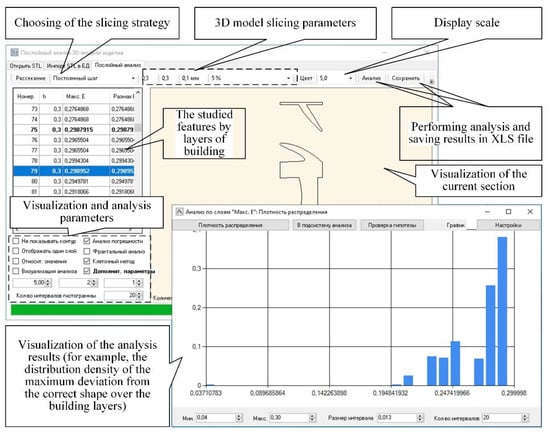
Figure 1.
Subsystem layered analysis of 3D model.
The developed subsystem provides the user with the following basic capabilities:
- -
- creating a set of layers with 2D sections based on a polygonal 3D model of the product (STL-file) according to a given building strategy (with a constant or variable step);
- -
- visualization of product section contour for the current layer;
- -
- statistical analysis and construction of histograms of studied features distribution;
- -
- determination of the main statistical characteristics of studied features, which are displayed in a single table for all layers;
- -
- output of a visualization form of analysis results in the form of density, integral probability function or dependence on the coordinates of layers along the Z-axis.
The transition from the original triangulated 3D model product to a set of layers was carried out according to procedures that were developed taking into account existing works [44,45,47,61], implementing strategies with a constant and variable step of slicing.
Slicing with a constant step was performed at hi = 0.1 mm. Adaptive slicing with variable, with steps in the range of hi ∈ [0.1, 0.3] mm. Building steps for adaptive slicing were determined, taking into account the permissible (maximum) error of layered shaping ΔS = 0.1 mm (which arises as a result of stepped effect on the surface) based on the following constraints [36]:
where hiC is the calculated value of building step, ; is the minimum angle between Z axis and normals of the faces in current layer; and hmin, hmax are the acceptable range of the variable step, minimum (hmin = 0.1 mm) and maximum (hmax = 0.3 mm).
The study of the possibilities of statistical analysis of the characteristics of the layered building was performed using products with complex surfaces. Four of these products are presented in Figure 2.
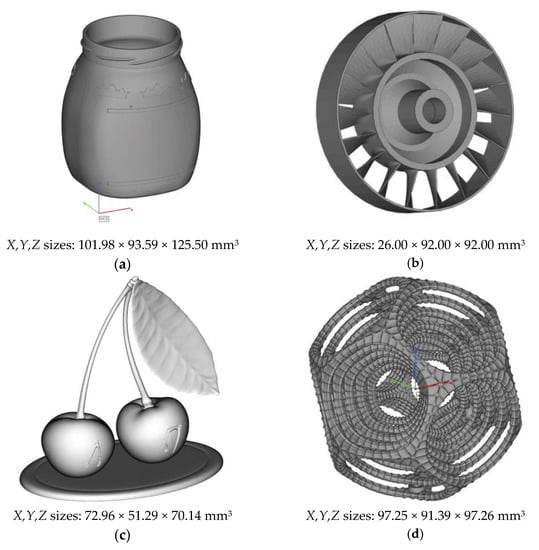
Figure 2.
Test 3D models of products: (a) the 1st test 3D model; (b) the 2nd test 3D model; (c) the 3rd test 3D model; (d) the 4th test 3D model.
4. Results
The research consisted of several stages. At the first stage, a set of models with different orientations in the workspace was created. Transformation of the coordinate system of 3D model was carried out by rotating around the X and Y axes [70]. Rotational angles αx, αy ∈ [0°, 180°) were set with a discreteness of 30°. As a result, the set contained 36 models with different orientations. At the second stage, by 3D model slicing according to strategy with a constant or variable step, a set of layers was obtained for each variant of product orientation. At the third stage, we performed a statistical distribution analysis of the values of the following research characteristics of the sets of layers: the building step hi (only for adaptive slicing with a variable step) and deviations from the correct form of surfaces ΔSi. Standard indicators [36] were also considered: the building height HBuild, height of gravity centre of the product HC, and the number of layers Nl. Table 1 shows the results of statistical analysis of research characteristics for all orientations of test 3D models (see Figure 2).

Table 1.
Statistical analysis of studied characteristics for a set of orientations of test 3D models.
Based on the results of model research (Table 1), particular patterns have been identified which are determined by the design features of certain product. This situation requires preliminary analysis for each 3D model that is undergoing technological preparation for additive manufacturing. For some technologies, the number of layers is the main characteristic that determines the production time. For example, for SLS technology, construction time Twork does not particularly depend on the cross-sectional area; therefore, dependence Twork = f(Nl) is approximately linear, regardless of the selected slicing strategy (with a constant or variable building step) [36].
Figure 3 shows the graphs of revealed dependences of the number of building layers Nl on the angles αx, αy of rotation of the 3D model (see Figure 2c) around the coordinate X and Y axes. Dependences Nl = f(αx, αy) were considered for two strategies: 3D model slicing with a constant (Figure 3a) and with a variable (Figure 3b) step. When building with a constant step, the number of layers Nl is determined by the ratio of the building height HBuild to the step hi (layer thickness). For a strategy with a variable step, the number of layers Nl is determined by the HBuild and geometric complexity of product, taking into account dependence (1).
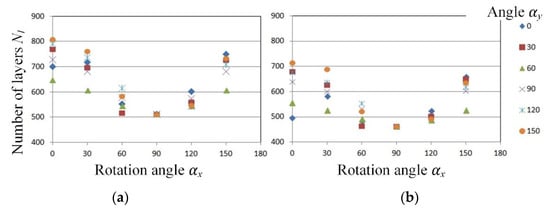
Figure 3.
Dependence of the number of building layers Nl on the angles αx, αy of rotation of a 3D model coordinate system by slicing with (a) constant step and (b) variable step.
Model data (Figure 3) show that the strategy with variable building step, determined by dependence (1), makes it possible to reduce the number of layers by 8–29% depending on the product orientation. Thus, the scientific hypothesis put forward about the need to combine two optimization tasks—model orientation and adaptive slicing—is confirmed.
Comparative analysis of distributions of the studied characteristics is quite informative when using box-and-whisker plots. Such charts show information on the quartiles of the studied values’ distribution. Comparison of several variants of slicing for test models on one diagram (Figure 4) expands the possibilities of visual analysis.
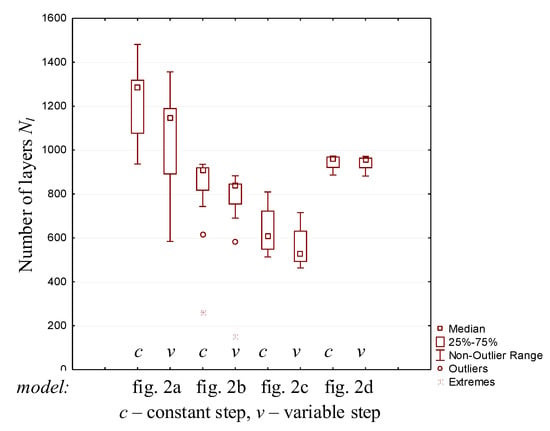
Figure 4.
Statistical analysis of the number of layers for building test models for all orientations.
The general results obtained (see Figure 4) comparing slicing strategies with a constant and variable step show a clear advantage of adaptive slicing. The most successful building is the first product (Figure 2a), which allows us to reduce the number of layers depending on selected orientation by 7.3 ÷ 53.5% (an arithmetic mean value of 16.0%). The fourth product (Figure 2d), which has complex surfaces and a slightly different build height for orientation options, belongs to the least successful building (see Table 1). For this product, both tasks—rational orientation and slicing—are not relevant, since they do not allow us to significantly reduce the number of layers. The decrease in the number of layers is, depending on the chosen orientation, by 0 ÷ 2.8% (the arithmetic mean is 0.3%). Thus, the significance of the influence of product construction on the efficiency of solving the problems under consideration is confirmed. It can also be concluded that there is no need to solve both separately considered tasks and jointly considered tasks for products with complex surfaces and ambiguously determined orientations in the workspace of layered manufacturing.
The model was verified by assessing deviations from the correct shape ΔS, given by the 3D model, resulting from steps formed on the surface due to layered building. The value of ΔSi by (1) depends on the angle of inclination relative to the Z-axis of the surface normal vector and building step. Examples of distribution of shaping errors (deviations from the correct shape) of the original 3D model are shown in Figure 5.
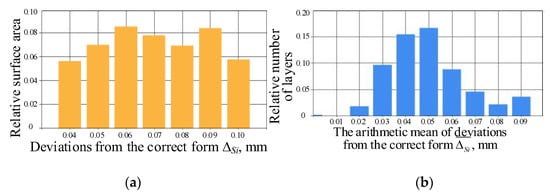
Figure 5.
Densities of distribution of investigated characteristic of the layered building: (a) deviations from the correct form ΔS in the 8th layer; (b) arithmetic mean values ΔS over build layers.
Statistical analysis of the distribution of values of deviation from the correct shape of surfaces ΔSi was carried out on basis of layer-by-layer consideration of the studied features. We consider this approach to be correct for the layer-by-layer process of building a product. In each layer, the distribution of deviations ΔSi was analysed separately. Figure 5a shows an example of the analysis of the distribution of deviations from the correct shape ΔSi for a single n-th layer in relation to the model shown in Figure 2c. Figure 5b shows the distribution of arithmetic mean values of deviations ΔSi over all layers.
The arithmetic mean value of deviations from the correct shape of surfaces is quite acceptable for assessing the validity of build step selection. Taking into account the significant influence of the geometric features of the product on the choice of slicing parameters, a comparative statistical analysis was performed to test 3D models (see Figure 2). Figure 6 and Figure 7 show the analysis results for orientation options of the 3D models for a constant and variable build step.
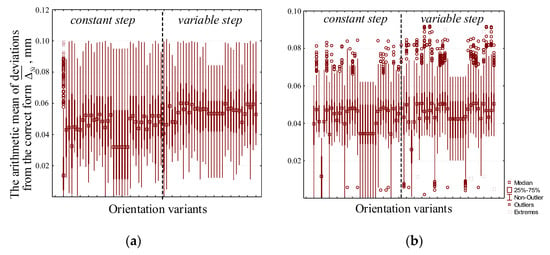
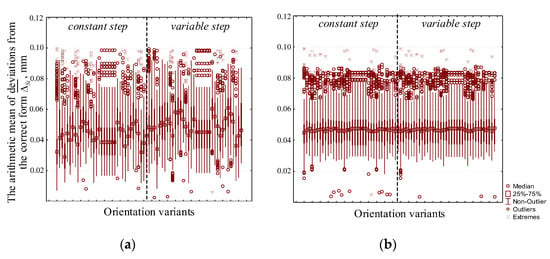
In all cases, products obtained with a variable building step have large deviations in comparison with a constant building step.
The first test 3D model allows us, due to the selection of a rational orientation, to significantly reduce the number of building layers and, accordingly, increase the values by 76.8 ÷ 174.5% (with a constant step). With a variable step, compared with a constant step, they increase by 7.8 ÷ 114.0%. Joint solution of tasks leads to a change of 114.0 ÷ 210.8%.
For the second test 3D model, depending on the orientation, the values increase by −64.1 ÷ 25.2%. With a variable step, the values are additionally increased by 5.5 ÷ 72.3%. Joint solution of tasks leads to a change by −38.2 ÷ 36.4%.
Standard deviation from the mean value ΔSi over build layers varies in the range of values σ{ΔSi} [0, 0.04] mm for all orientations of the 3D model, as shown in Figure 2a. In most cases of orientation, σ{ΔSi}
[0.010, 0.028] mm.
According to the analysis results for the third test 3D model (Figure 2c) in the considered orientation options, most (75 ÷ 100%) of the building steps are in the range hi [0.10, 0.16] mm, with the maximum allowable value hmax = 0.3 mm. At the same time, the analysis of deviations from the correct form ΔS (Figure 7a) with different orientations made it possible to reveal the following ranges of the value by −13.6 ÷ 46.9% (at a constant step). With a variable step, the values are additionally increased by −14.7 ÷ 56.3%. Joint solution of tasks leads to a change in by 1.4 ÷ 6.1%.
The analysis results for the fourth 3D model are fundamentally different due to the complex geometry of the product surface and almost constant build height for all orientation in the workspace. Depending on the orientation, the values increase by 0.5 ÷ 2.5% (at a constant step). With a variable step, the values are additionally increased by 0 ÷ 1.4%. Joint solution of tasks leads to a change in by 0.8 ÷ 2.8%.
The obtained results of model studies confirm the correctness of chosen direction of research to create the foundations of a comprehensive solution to optimization tasks.
5. Conclusions
Statistical analysis of the characteristics of the layered slicing of the 3D model made it possible to evaluate the effectiveness of the implementation of the joint solution of optimization tasks to determine the parameters of the adaptive slicing of 3D models and their orientation in the workspace of the additive machine.
Joint solution of the considered optimization tasks made it possible to test 3D models to reduce their number of building layers, depending on the chosen orientation, by 54%, with an increase in the arithmetic mean of deviations from the correct surface shape to 211%. At the same time, the specified requirements for the maximum permissible deviation , given by triangulated 3D model of the product, were satisfied.
The geometry of the product significantly affects the resulting efficiency of the joint solution of the considered problems of technological process planning for additive manufacturing. For a test 3D model of a product with complex geometry and insignificant differences in overall dimensions, regardless of the selected orientation, it is not advisable to use adaptive slicing to perform a joint solution with the task of determining rational orientation.
Further research should be aimed at assessing the effectiveness of the joint solution of three optimization problems for the additive manufacture of a group of products rational orientation, placement (packing) and adaptive slicing. Also of interest is the comparative statistical analysis of studied features when using optimization criteria based on the characteristics of the physical and mechanical properties of resulting products.
Author Contributions
Conceptualization, Y.G. and V.F.; methodology, Y.G.; software, Y.G.; validation, V.F., Y.O., P.D., M.A. and H.O.; formal analysis, P.D.; investigation, Y.G.; resources, Y.O.; data curation, Y.G.; writing—original draft preparation, Y.G.; writing—review and editing, Y.O. and P.D.; project administration, Y.O. All authors have read and agreed to the published version of the manuscript.
Funding
This research was funded by Ministry of Education and Science of Ukraine, grant number 0122U001435.
Data Availability Statement
Not applicable.
Conflicts of Interest
The authors declare no conflict of interest.
References
- Baumers, M. Economic Aspects of Additive Manufacturing: Benefits, Costs and Energy Consumption. Ph.D. Thesis, Loughborough University, Loughborough, UK, 2012; 266p. Available online: https://dspace.lboro.ac.uk/2134/10768 (accessed on 25 October 2022).
- Zhang, Y.; Bernard, A. AM Feature and Knowledge Based Process Planning for Additive Manufacturing in Multiple Parts Production Context. In Proceedings of the 25th Annual International Solid Freeform Fabrication Symposium, Austin, TX, USA, 4–6 August 2014; pp. 1259–1276. [Google Scholar]
- Byun, H.S.; Lee, K.H. Determination of optimal build direction in rapid prototyping with variable slicing. Byun, H.S.; Lee, K.H. Determination of optimal build direction in rapid prototyping with variable slicing. Int. J. Adv. Manuf. Technol. 2006, 28, 307–313. [Google Scholar] [CrossRef]
- Canellidis, V.; Giannatsis, J.; Dedoussis, V. Genetic-algorithm-based multi-objective optimization of the build orientation in stereolithography. Int. J. Adv. Manuf. Technol. 2009, 45, 714–730. [Google Scholar] [CrossRef]
- Alagha, A.N.; Hussain, S.; Zaki, W. Additive manufacturing of shape memory alloys: A review with emphasis on powder bed systems. Mater. Des. 2021, 204, 109654. [Google Scholar] [CrossRef]
- Derekar, K.S. A review of wire arc additive manufacturing and advances in wire arc additive manufacturing of aluminium. Mater. Sci. Technol. 2018, 34, 895–916. [Google Scholar] [CrossRef]
- Frazier, W.E. Metal additive manufacturing: A review. J. Mater. Eng. Perform. 2014, 23, 1917–1928. [Google Scholar] [CrossRef]
- Gonzalez-Gutierrez, J.; Cano, S.; Schuschnigg, S.; Kukla, C.; Sapkota, J.; Holzer, C. Additive manufacturing of metallic and ceramic components by the material extrusion of highly-filled polymers: A review and future perspectives. Materials 2018, 11, 840. [Google Scholar] [CrossRef] [PubMed]
- Gorsse, S.; Hutchinson, C.; Gouné, M.; Banerjee, R. Additive manufacturing of metals: A brief review of the characteristic microstructures and properties of steels, Ti-6Al-4V and high-entropy alloys. Sci. Technol. Adv. Mater. 2017, 18, 584–610. [Google Scholar] [CrossRef] [PubMed]
- Hehr, A.; Norfolk, M. A comprehensive review of ultrasonic additive manufacturing. Rapid Prototyp. J. 2020, 26, 445–458. [Google Scholar] [CrossRef]
- Ko, G.-B.; Kim, W.-S.; Kwon, K.-J.; Lee, T.-K. The corrosion of stainless steel made by additive manufacturing: A review. Metals 2021, 11, 516. [Google Scholar] [CrossRef]
- Liu, S.; Shin, Y.C. Additive manufacturing of Ti6Al4V alloy: A review. Mater. Des. 2019, 164, 107552. [Google Scholar] [CrossRef]
- Kumar, R.; Kumar, M.; Chohan, J.S. The role of additive manufacturing for biomedical applications: A critical review. J. Manuf. Process. 2021, 64, 828–850. [Google Scholar] [CrossRef]
- Suwanpreecha, C.; Manonukul, A. A review on material extrusion additive manufacturing of metal and how it compares with metal injection moulding. Metals 2022, 12, 429. [Google Scholar] [CrossRef]
- Yang, S.; Zhao, Y.F. Additive manufacturing-enabled design theory and methodology: A critical review. Int. J. Adv. Manuf. Technol. 2015, 80, 327–342. [Google Scholar] [CrossRef]
- Zhu, Z.; Dhokia, V.G.; Nassehi, A.; Newman, S.T. A review of hybrid manufacturing processes—State of the art and future perspectives. Int. J. Comput. Integr. Manuf. 2013, 26, 596–615. [Google Scholar] [CrossRef]
- Kumar, S.; Kar, A. A review of solid-state additive manufacturing processes. Trans. Indian Natl. Acad. Eng. 2021, 6, 955–973. [Google Scholar] [CrossRef]
- Turner, B.N.; Strong, R.; Gold, S.A. A review of melt extrusion additive manufacturing processes: I. Process design and modeling. Rapid Prototyp. J. 2014, 20, 192–204. [Google Scholar] [CrossRef]
- Zhang, Y.; Wu, L.; Guo, X.; Kane, S.; Deng, Y.; Jung, Y.-G.; Lee, J.-H.; Zhang, J. Additive manufacturing of metallic materials: A review. J. Mater. Eng. Perform. 2017, 27, 1–13. [Google Scholar] [CrossRef]
- Mahmood, M.A.; Bănică, A.; Ristoscu, C.; Becherescu, N.; Mihăilescu, I.N. Laser coatings via state-of-the-art additive manufacturing: A review. Coatings 2021, 11, 296. [Google Scholar] [CrossRef]
- Moghaddam, A.O.; Shaburova, N.A.; Samodurova, M.N.; Abdollahzadeh, A.; Trofimov, E.A. Additive manufacturing of high entropy alloys: A practical review. J. Mater. Sci. Technol. 2021, 77, 131–162. [Google Scholar] [CrossRef]
- Monfared, V.; Bakhsheshi-Rad, H.R.; Ramakrishna, S.; Razzaghi, M.; Berto, F. A brief review on additive manufacturing of polymeric composites and nanocomposites. Micromachines 2021, 12, 704. [Google Scholar] [CrossRef]
- Reichardt, A.; Shapiro, A.A.; Otis, R.; Dillon, R.P.; Borgonia, J.P.; McEnerney, B.W.; Hosemann, P.; Beese, A.M. Advances in additive manufacturing of metal-based functionally graded materials. Int. Mater. Rev. 2020, 66, 1–29. [Google Scholar] [CrossRef]
- Singh, S.; Ramakrishna, S.; Singh, R. Material issues in additive manufacturing: A review. J. Manuf. Process. 2017, 25, 185–200. [Google Scholar] [CrossRef]
- Vaezi, M.; Chianrabutra, S.; Mellor, B.; Yang, S. Multiple material additive manufacturing—Part 1: A review. Virtual Phys. Prototyp. 2013, 8, 19–50. [Google Scholar] [CrossRef]
- Turner, B.N.; Gold, S.A. A review of melt extrusion additive manufacturing processes: II. Materials, dimensional accuracy and surface roughness. Rapid Prototyp. J. 2015, 21, 250–261. [Google Scholar] [CrossRef]
- Dašić, P. Response Surface Methodology: Selected Scientific-Professional Papers; SaTCIP Publisher Ltd.: Vrnjačka Banja, Serbia, 2019; 301p. [Google Scholar]
- Dašić, P. Comparative analysis of different regression models of the surface roughness in finishing turning of hardened steel with mixed ceramic cutting tools. J. Res. Dev. Mech. Ind. 2013, 5, 101–180. [Google Scholar]
- Pandey, P.M.; Thrimurtullu, K.; Reddy, N.V. Optimal part deposition orientation in FDM by using a multi-criteria Genetic Algorithm. Int. J. Prod. Res. 2004, 42, 4069–4089. [Google Scholar] [CrossRef]
- Das, P.; Chandran, R.; Samant, R.; Anand, S. Optimum Part Build Orientation in Additive Manufacturing for Minimizing Part Errors and Support Structures. Procedia Manuf. 2015, 1, 343–354. [Google Scholar] [CrossRef]
- Lan, P.; Chou, S.; Chen, L.; Gemmill, D. Determining fabrication orientations for rapid prototyping with Stereolithography apparatus. Comput. -Aided Des. 1997, 29, 53–62. [Google Scholar] [CrossRef]
- Singhal, S.K.; Pandey, A.P.; Pandey, P.M.; Nagpal, A.K. Optimum part deposition orientation in stereolithography. Comput. -Aided Des. Appl. 2005, 2, 319–328. [Google Scholar] [CrossRef]
- Marsan, A.; Dutta, D. A Survey of Process Planning Techniques for Layered Manufacturing. In Proceedings of the DETC’97, 1997 ASME Design Engineering Technical Conferences, Sacramento, CA, USA, 14–17 September 1997. [Google Scholar]
- Bablani, M.; Bagchi, A. Quantification of errors in rapid prototyping processes, and determination of preferred orientation of parts. Trans. North American Manuf. Res. Inst. SME 1995, 23, 319–324. [Google Scholar]
- Thompson, D.C.; Crawford, R.H. Optimizing part quality with orientation. In Proceedings of the Solid Freeform Fabrication Symposium 1995, University of Texas, Austin, TX, USA, 7–9 August 1995; Volume 6, pp. 362–368. [Google Scholar]
- Vityazev, Y.B. Expansion of Technological Capabilities of Accelerated Shaping by Stereolithography. Cand. Tech. Sciences Thesis, Kharkiv, 2004; 228p. (In Russian). [Google Scholar]
- Abdurayimov, L.N.; Chernyshov, S.I.; Dobroskok, V.L.; Vityazev, Y.B. The Method of Layer-By-Layer Building of Products Based on the Original Triangulation 3D Model. Patent 54398U Ukraine; № u201004548, 10 November 2010. (In Ukrainian). [Google Scholar]
- Wodziak, J.R.; Fadel, G.M.; Kirschman, C. A Genetic Algorithm for Optimizing Multiple Part Placement to Reduce Build Time. In Proceedings of the 5th International Conference on Rapid Prototyping, University of Dayton, Dayton, OH, USA, 12–15 June 1994; pp. 201–210. [Google Scholar]
- Beascoechea, A.; Wozny, M.J. On Three-Dimensional Heuristic Packing for Solid Freeform Fabrication. In Proceedings of the Solid Freeform Fabrication Symposium 1995, University of Texas, Austin, TX, USA, 7–9 August 1995; pp. 326–341. Available online: https://repositories.lib.utexas.edu/handle/2152/69341 (accessed on 25 October 2022).
- Deckard, C.R. Method and Apparatus for Producing Parts by Selective Sintering. U.S. Patent 4,863,538; № 920580, 5 September 1989. Available online: https://www.google.com.ua/patents/US4863538 (accessed on 25 October 2022).
- Dobroskok, V.L.; Chernyshov, S.I.; Vityazev, Y.B.; Abdurayimov, L.N. A Method of Layered Building of Products Based on Triangulation 3D Model. Patent 46418U Ukraine; № u200905500, 25 December 2009. (In Ukrainian). [Google Scholar]
- Chalasani, K.L.; Grogan, B.N.; Bagchi, A.; Jara-Almonte, C.C.; Ogale, A.A.; Dooley, R.L. An algorithm to slice 3D shapes for reconstruction in prototyping systems. In Proceedings of the 1991 ASME Computers in Engineering Conference, 18–22 August 1991; pp. 209–216. [Google Scholar]
- Kirschman, C.F.; Jara-Almonte, C.C. A Parallel Slicing Algorithm for Solid Freeform Fabrication Processes. In Proceedings of the Proceedings for the 1992 International Solid Freeform Fabrication Symposium, University of Texas, Austin, TX, USA, 3–5 August 1992; pp. 26–33. [Google Scholar]
- Dolenc, A.; Makela, I. Slicing procedures for layered manufacturing techniques. Comput. -Aided Des. 1994, 26, 119–126. [Google Scholar] [CrossRef]
- Sabourin, E.; Houser, S.A.; Bohn, J.H. Adaptive slicing using stepwise uniform refinement. Rapid Prototyp. J. 1996, 2, 20–26. [Google Scholar] [CrossRef]
- Chen, X.; Wang, C.; Ye, X. and other. Direct slicing from PowerSHAPE models for Rapid Prototyping. Int. J. Adv. Manuf. Technol. 2001, 17, 543–547. [Google Scholar] [CrossRef]
- Sun, S.H.; Chiang, H.W.; Lee, M.I. Adaptive direct slicing of a commercial CAD model for use in rapid prototyping. Int. J. Adv. Manuf. Technol. 2007, 34, 689–701. [Google Scholar] [CrossRef]
- Jamieson, R.; Hacker, H. Direct slicing of CAD models for rapid prototyping. Rapid Prototyp. J. 1995, 1, 4–12. [Google Scholar] [CrossRef]
- Sikder, S.; Barari, A.; Kishawy, H.A. Global adaptive slicing of NURBS based sculptured surface for minimum texture error in rapid prototyping. Rapid Prototyp. J. 2015, 21, 649–661. [Google Scholar] [CrossRef]
- Kulkarni, P.; Dutta, D. Adaptive slicing of parametrizable algebraic surfaces for layered manufacturing. In Proceedings of the 1995 ASME Design Engineering Technical Conferences, Boston, MA, USA, 17–20 September 1995; Volume 1, pp. 211–217. [Google Scholar]
- Cao, W.; Miyamoto, Y. Direct slicing from AutoCAD solid models for rapid prototyping. Int. J. Adv. Manuf. Technol. 2003, 21, 739–742. [Google Scholar] [CrossRef]
- Zhou, M.Y.; Xi, J.T.; Yan, J.Q. Adaptive direct slicing with non-uniform cusp heights for rapid prototyping. Int. J. Adv. Manuf. Technol. 2004, 23, 20–27. [Google Scholar] [CrossRef]
- Jin, G.Q.; Li, W.D.; Gao, L. An adaptive process planning approach of rapid prototyping and manufacturing. Robot. Comput. Manuf. 2013, 29, 23–38. [Google Scholar] [CrossRef]
- Wang, W.; Chao, H.; Tong, J.; Yang, Z.; Tong, X.; Li, H.; Liu, X.; Liu, L. Saliency-Preserving Slicing Optimization for Effective 3D Printing. Comput. Graph. Forum 2015, 34, 148–160. [Google Scholar] [CrossRef]
- Dobroskok, V.L.; Garashchenko, Y.M. Method of Layered Building of Products with Variable Layer Thickness Based on Triangulation 3D Model. Patent 117764 UA; № u201700070, 10 July 2017. [Google Scholar]
- Tyberg, J.; Bohn, J.H. Local adaptive slicing. Rapid Prototyp. J. 1998, 4, 118–127. [Google Scholar] [CrossRef]
- Cormier, D.; Unnanon, K.; Sanni, E. Specifying non-uniform cusp heights as a potential for adaptive slicing. Rapid Prototyp. J. 2000, 6, 204–212. [Google Scholar] [CrossRef]
- Panhalkar, N.; Paul, R.; Anand, S. Increasing Part Accuracy in Additive Manufacturing Processes Using a k-d Tree Based Clustered Adaptive Layering. J. Manuf. Sci. Eng. 2014, 136, 061017. [Google Scholar] [CrossRef]
- Nadiyapara, H.H.; Pande, S. A Review of Variable Slicing in Fused Deposition Modeling. J. Inst. Eng. (India) Ser. C 2016, 98, 387–393. [Google Scholar] [CrossRef]
- Li, Q.; Xu, X.Y. Self-adaptive slicing algorithm for 3D printing of FGM components. Mater. Res. Innov. 2015, 19 (Suppl. S5), S635–S641. [Google Scholar] [CrossRef]
- Pandey, M.P.; Reddy, V.N.; Dhande, S.G. Slicing procedures in layered manufacturing: A review. Rapid Prototyp. J. 2003, 9, 274–288. [Google Scholar] [CrossRef]
- Gupta, V.; Bajpai, V.; Tandon, P. Slice Generation and Data Retrieval Algorithm for Rapid Manufacturing of Heterogeneous Objects. Comput. -Aided Des. Appl. 2013, 11, 255–262. [Google Scholar] [CrossRef]
- Pan, X.D.; Chen, K.; Zhang, Z.Y.; Chen, D.F.; Li, T.T. Adaptive Slicing Algorithm Based on STL Model. Appl. Mech. Mater. 2013, 288, 241–245. [Google Scholar] [CrossRef]
- Pandey, P.M.; Reddy, N.V.; Dhande, S.G. Real time adaptive slicing for fused deposition modelling. Int. J. Mach. Tools Manuf. 2003, 43, 61–71. [Google Scholar] [CrossRef]
- Singhal, S.K.; Jain, P.K.; Pandey, P.M. Adaptive Slicing for SLS Prototyping. Comput. -Aided Des. Appl. 2013, 5, 412–423. [Google Scholar] [CrossRef]
- Sikder, S.; Barari, A.; Kishawy, H.A. Control of NURBS-Based Surface Error Factor Using a Manufacturing Cost Optimization in Rapid Prototyping Process. IFAC Proc. Vol. 2013, 46, 1560–1565. [Google Scholar] [CrossRef]
- Taufik, M.; Jain, P.K. Volumetric Error Control in Layered Manufacturing. In Proceedings of the ASME 2014 International Design Engineering Technical Conferences and Computers and Information in Engineering Conference, Buffalo, NY, USA, 17–20 August 2014; Volume 4. [Google Scholar] [CrossRef]
- Siraskar, N.; Paul, R.; Anand, S. Adaptive Slicing in Additive Manufacturing Process Using a Modified Boundary Octree Data Structure. J. Manuf. Sci. Eng. 2014, 137, 011007. [Google Scholar] [CrossRef]
- Boschetto, A.; Giordano, V.; Veniali, F. 3D roughness profile model in fused deposition modelling. Rapid Prototyp. J. 2013, 19, 240–252. [Google Scholar] [CrossRef]
- Qin, Y.; Qi, Q.; Shi, P.; Scott, P.J.; Jiang, X. Status, issues, and future of computer-aided part orientation for additive manufacturing. Int. J. Adv. Manuf. Technol. 2021, 115, 1295–1328. [Google Scholar] [CrossRef]
Disclaimer/Publisher’s Note: The statements, opinions and data contained in all publications are solely those of the individual author(s) and contributor(s) and not of MDPI and/or the editor(s). MDPI and/or the editor(s) disclaim responsibility for any injury to people or property resulting from any ideas, methods, instructions or products referred to in the content. |
© 2023 by the authors. Licensee MDPI, Basel, Switzerland. This article is an open access article distributed under the terms and conditions of the Creative Commons Attribution (CC BY) license (https://creativecommons.org/licenses/by/4.0/).